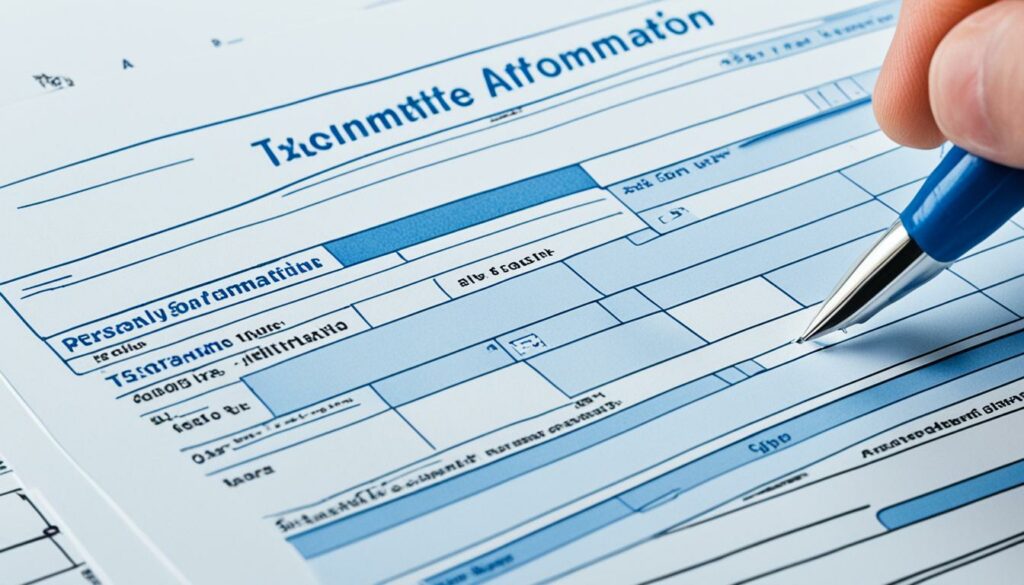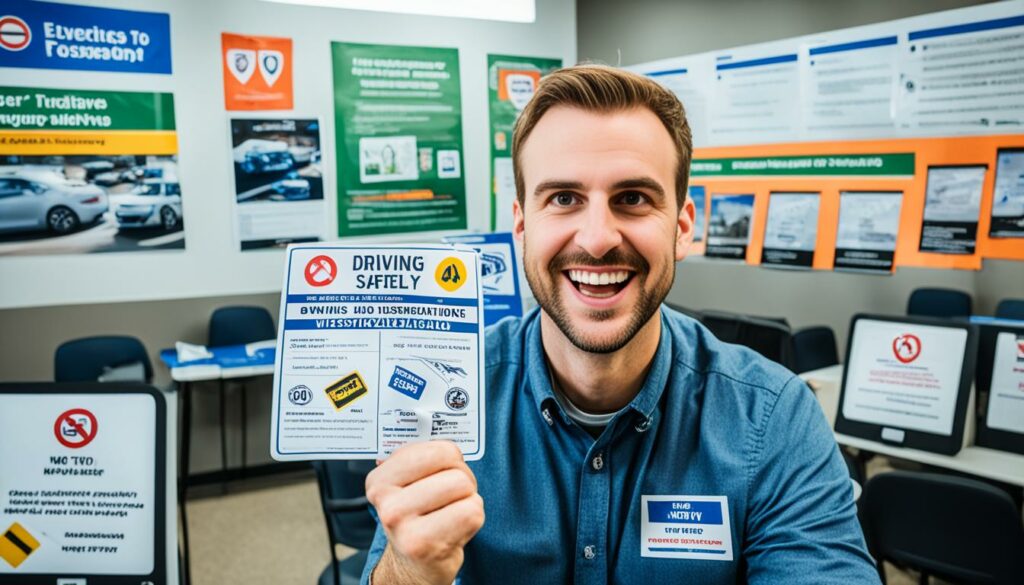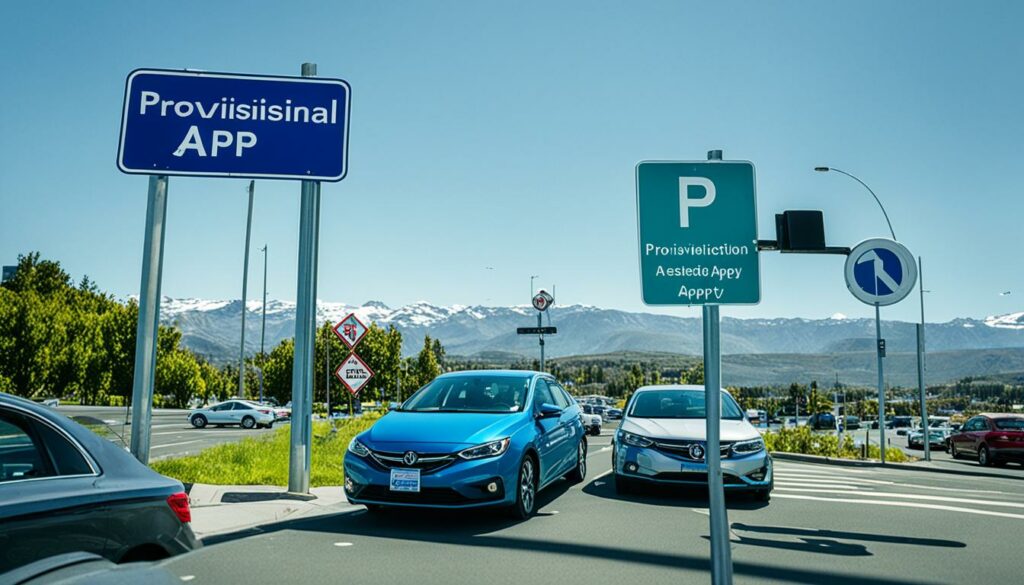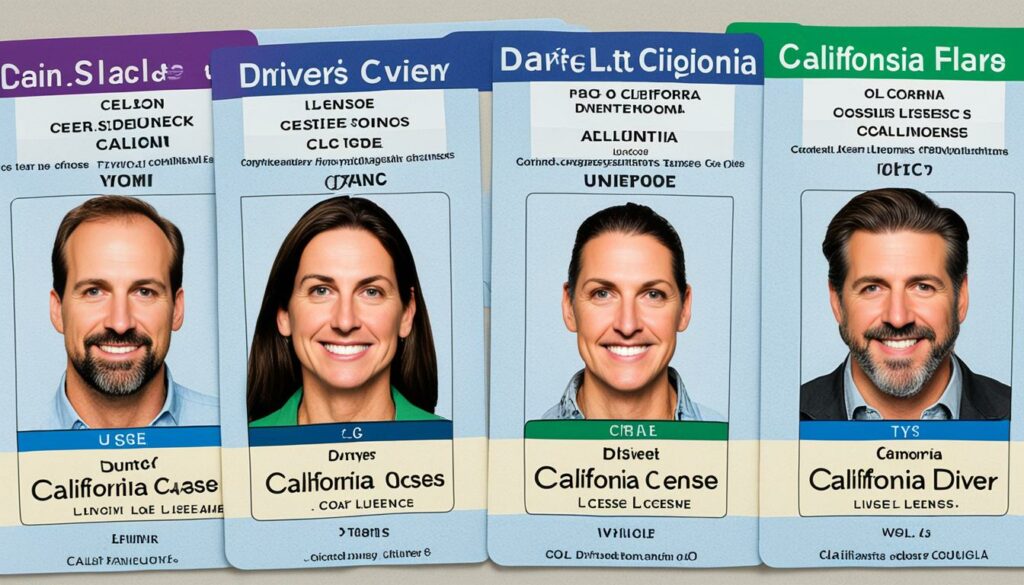Drivers License Requirements – Essential Guide
To legally drive in the United States, it is important to understand the driver license requirements. Whether you are a new driver or looking to renew your license, meeting these requirements is crucial. In this comprehensive guide, we will explore the eligibility criteria and the process of obtaining a driver license in the United States.
Key Takeaways:
- Obtaining a driver’s license in the United States requires meeting specific requirements and completing necessary steps.
- Requirements typically include proof of identity, residency, and completing driver education and training.
- Eligibility criteria may vary from state to state, so it’s important to check the specific requirements in your state.
- Applying for an instruction permit is often the first step for individuals without a driver’s license.
- Provisional drivers, usually under 18 years old, have certain restrictions on their licenses.
Applying for an Instruction Permit

Before taking the behind-the-wheel drive test to obtain a driver’s license, individuals who do not have a driver’s license from California or another state must first apply for an instruction permit. The process for applying for a Class C instruction permit includes the following steps:
- Step 1: Complete the Driver’s License Application
- Step 2: Gather the Necessary Documents
- Step 3: Pay the Application Fee
- Step 4: Pass the Knowledge and Vision Tests
- Step 5: Obtain Parent or Guardian Approval
First, applicants need to complete the driver’s license application. This can typically be done online or in person at the local Department of Motor Vehicles (DMV) office. The application will require personal information, such as name, date of birth, address, and social security number.
Next, applicants must gather the necessary documents to prove their identity and residency. These documents may include a birth certificate, passport, proof of residency, and social security card. It is important to review the specific requirements outlined by the DMV to ensure all necessary documentation is provided.
Afterward, applicants will need to pay the application fee, which is typically around $35. This fee helps cover the administrative costs associated with processing the application.
Once the application is submitted, applicants will need to pass the knowledge and vision tests. The knowledge test assesses understanding of traffic laws, road signs, and safe driving practices. The vision test ensures that applicants meet the visual acuity standards necessary for safe driving.
Finally, applicants who are under the age of 18 must have a parent or guardian sign to approve the application. This signature indicates that the parent or guardian is aware of and supports the individual’s intent to obtain an instruction permit.
It is important to note that the minimum age requirement for obtaining an instruction permit in California is 15½ years old. Individuals must meet this age requirement before applying for an instruction permit.
| Step | Description |
|---|---|
| Step 1 | Complete the Driver’s License Application |
| Step 2 | Gather the Necessary Documents |
| Step 3 | Pay the Application Fee |
| Step 4 | Pass the Knowledge and Vision Tests |
| Step 5 | Obtain Parent or Guardian Approval |
Once the instruction permit is obtained, individuals can start practicing driving under the supervision of a licensed adult. This permit serves as a valuable opportunity to gain experience and develop the necessary skills to become a safe and responsible driver.
Why is an Instruction Permit Important?
An instruction permit provides individuals with the chance to practice their driving skills and gain valuable experience before obtaining a driver’s license.
By following the instruction permit application process, individuals can begin their journey towards becoming a licensed driver in California. Obtaining an instruction permit is an important step in learning the rules of the road, building confidence behind the wheel, and ultimately earning a driver’s license.
Obtaining a Driver’s License

Obtaining a driver’s license in California requires individuals to meet specific criteria. These requirements ensure that drivers have the necessary skills and knowledge to safely operate a vehicle on the roads. The process of getting a driver license involves several steps and qualifications.
Driver License Process
The driver license process in California involves the following steps:
- Be at least 16 years old: Individuals must meet the minimum age requirement to be eligible for a driver’s license.
- Hold an instruction permit for at least 6 months: Before applying for a driver’s license, individuals need to have an instruction permit from California or another state for a specified duration.
- Complete driver education and training: To obtain a driver’s license, individuals must complete driver education and training programs. These programs provide essential knowledge and practice to develop safe driving habits.
- Practice driving for at least 50 hours: As part of the driver license process, aspiring drivers must accumulate a minimum of 50 hours of driving practice with a licensed driver who is at least 25 years old. This practice ensures that individuals have sufficient experience behind the wheel before obtaining their license.
It is crucial to note that the requirements and steps for obtaining a driver’s license may vary from state to state. It is advisable to consult the official DMV website for specific information regarding the driver license process in your state.
Requirements for a Driver License
In addition to the driver license process, there are specific requirements that individuals must meet to obtain a driver’s license. These requirements include:
- Proof of identity: Individuals need to provide valid identification documents to establish their identity. This typically includes documents such as a birth certificate, passport, or social security card.
- Proof of residency: Proof of residency documents, such as utility bills or lease agreements, are required to demonstrate that the individual is a resident of the state where they are applying for a driver’s license.
- Passing the written permit test: To obtain a driver’s license, individuals must pass a written permit test that assesses their knowledge of traffic laws and regulations.
- Passing the behind-the-wheel test: The final step of the driver license process is the behind-the-wheel test, where individuals showcase their driving skills and ability to follow the rules of the road.
By meeting these requirements and successfully completing the driver license process, individuals can obtain their driver’s license and enjoy the freedom and responsibilities that come with it.
Restrictions for Provisional Drivers

Provisional drivers in California face specific restrictions on their driver’s licenses. These restrictions are in place to ensure the safety of new and inexperienced drivers. It’s important for provisional drivers to be aware of and abide by these restrictions to avoid any legal consequences and to keep themselves and others safe on the road.
Provisional Driver Restrictions:
- Provisional drivers cannot drive between 11 p.m. and 5 a.m. during the first 12 months of having their license. This limitation helps prevent young and inexperienced drivers from driving during the riskiest times of day and reduces the likelihood of accidents that can be caused by fatigue or impaired driving.
- Provisional drivers cannot have passengers under 20 years old unless accompanied by a parent or guardian or another licensed driver who is at least 25 years old. This restriction aims to reduce distractions and promote safer driving conditions for new drivers, as passengers can often be a source of distractions and peer pressure.
- Provisional drivers are not permitted to operate commercial vehicles that require a commercial Class A, B, or C license. This restriction acknowledges that operating commercial vehicles requires additional training and experience beyond what is expected of provisional drivers.
It’s essential for provisional drivers to understand and comply with these restrictions. Failure to adhere to these limitations can result in penalties, such as fines, license suspension, or even an extension of the provisional period. There are, however, exceptions to these restrictions for specific circumstances, such as medical needs or driving for school or work reasons.
For more information on provisional driver restrictions and other regulations in California, visit the official California DMV website.
California Driver’s License Types and Real ID

When it comes to driver’s licenses in California, there are different types available based on the type of vehicle you plan to drive. While most people will need a noncommercial Class C driver’s license, there are also classes specifically for operating commercial vehicles, motorcycles, and other specialized vehicles. It’s essential to determine which class of license you need before applying to ensure you meet the necessary requirements and can legally operate the vehicle of your choice.
If you’re unsure about which class of license you need, refer to the official website of the California Department of Motor Vehicles (DMV) for detailed information. The website provides specific guidelines and requirements for each type of license, making it easy to determine the one that best suits your needs.
Additionally, it’s important to be aware of the Real ID requirements, which will become mandatory for certain purposes starting in May 2025. The Real ID Act, enforced by the federal government, establishes minimum security standards for state-issued driver’s licenses and identification cards. These credentials will be required for activities such as boarding an airplane or entering federal facilities where identification is necessary.
To ensure your driver’s license or identification card is Real ID compliant, you’ll need to provide the required documentation and complete the necessary processes outlined by the California DMV. It’s crucial to review the Real ID requirements and gather the appropriate documents in advance to avoid any delays or complications when it becomes mandatory.
Key Points:
- California offers different driver’s license classes based on the vehicle you plan to drive.
- Real ID compliance will be mandatory for certain purposes starting May 2025.
- Visit the official California DMV website for detailed information on license types and Real ID requirements.
Driver’s License Application Process
Applying for a driver’s license in California involves several steps and requirements. The application process is streamlined to ensure that individuals meet the necessary criteria before receiving their license. Here is an overview of the driver’s license application process:
- Visit the local DMV office: To begin the application process, individuals must visit their local DMV office. It’s advisable to make an appointment in advance to reduce wait times.
- Complete the application form: Fill out the Driver License or Identification Card Application (Form DL44). This form collects important information for identification purposes.
- Prove your identity: Provide the necessary documents to prove your identity. These may include a social security card, birth certificate, and residency documents. (Note: The sources provide specific details on the documents needed to prove identity).
- Pay the required fee: The driver’s license application fee is currently mentioned as $33 in the sources. Be sure to check the official DMV website for the most up-to-date fee information.
- Take a vision exam: A vision exam is conducted to ensure that applicants meet the minimum visual acuity requirements for safe driving.
- Potential written permit test and behind-the-wheel test: Depending on your situation, you may need to pass a written permit test and a behind-the-wheel test. These tests assess your knowledge of traffic laws and your ability to safely operate a motor vehicle.
Following these steps and meeting all the requirements will set you on the path to obtaining your California driver’s license. Remember to check the official DMV website for specific details and any additional steps that may be required.
Now, let’s take a look at the documents needed to prove your identity:
Documents Required for Proving Identity
| Document | Description |
|---|---|
| Social Security Card | Provides proof of your social security number. |
| Birth Certificate | Verifies your date of birth and legal full name. |
| Residency Documents | Documents such as utility bills, rental agreements, or property tax statements that establish your California residency. |
These documents are essential for proving your identity during the driver’s license application process. Ensure that you have all the required documents before visiting the DMV office to prevent any delays or complications.
Tips for Obtaining a California Driver’s License
If you’re looking to obtain a California driver’s license, here are some valuable tips to guide you through the process:
- Make an appointment: To avoid long wait times at the DMV, it’s recommended to schedule an appointment in advance. This can help streamline the application process and reduce the time spent waiting in line.
- Book the behind-the-wheel test early: The behind-the-wheel test is a crucial step towards obtaining your driver’s license. It’s advisable to book this test as soon as possible to secure a convenient date and time.
- Study and practice for the written permit test: The written permit test assesses your knowledge of traffic laws and regulations. To increase your chances of passing, dedicate adequate time to study the California Driver Handbook and practice with online resources or sample tests.
- Get tips and assistance from professionals: Consider enrolling in a driver education course or seeking guidance from driving instructors. They can provide valuable tips, practice exercises, and insights to help you prepare for both the written and behind-the-wheel tests.
- Be prepared and research the California road test: Familiarize yourself with the specific requirements and expectations of the California road test. Knowing what to expect will boost your confidence and ensure you’re fully prepared on test day.
- Take advantage of resources and services: Utilize online resources, study materials, and practice tests to enhance your knowledge and skills. Additionally, consider seeking assistance from DMV appointment services or appointment reminder tools to stay organized throughout the application process.
By following these tips and putting in the necessary effort, you can increase your chances of obtaining a California driver’s license successfully.
| Tips for Obtaining a California Driver’s License |
|---|
| Make an appointment |
| Book the behind-the-wheel test early |
| Study and practice for the written permit test |
| Get tips and assistance from professionals |
| Be prepared and research the California road test |
| Take advantage of resources and services |
Age Restrictions for Driver’s License
Obtaining a driver’s license in California has age restrictions that vary based on the individual’s age. Here’s a breakdown of the requirements:
- If you are 18 years or older, you can follow the standard process for obtaining a driver’s license, without any specific age restrictions.
- For individuals who are 16 years old, the process differs. They are eligible for a provisional license after completing a driver education course.
- Those who are 17½ years old can apply for a provisional permit without needing to take a driver’s education course.
It’s important to note that provisional licenses have certain restrictions and limitations, designed to ensure the safety of young and inexperienced drivers. These restrictions may include limits on driving at night, passenger restrictions, and restrictions on operating specific types of vehicles.
Remember that the requirements and restrictions may vary depending on the state. Be sure to familiarize yourself with the specific regulations in your state.
For a detailed overview of the age requirements and restrictions for obtaining a driver’s license in California, refer to the table below:
| Age | Requirements | Restrictions |
|---|---|---|
| 18 years or older | No specific age restrictions | No restrictions apply |
| 16 years old | Completion of driver education course | Provisional license with restrictions |
| 17½ years old | Eligible for provisional permit without driver education course | Provisional permit with restrictions |
Understanding the age requirements and restrictions for obtaining a driver’s license is crucial for aspiring drivers, as it ensures compliance with legal regulations and promotes safe driving practices.
Additional California DMV Information
When navigating the California DMV, it’s essential to have access to reliable resources and services. The California DMV provides a range of helpful tools and information to assist individuals in their driver’s license journey.
DMV Services for Veterans
For veterans in California, the DMV offers specialized services and benefits. These services include expedited processing for certain transactions, assistance with veteran designation on a driver’s license, and information on veteran-specific license plates. Veterans can visit their local DMV office or the official California DMV website for more details on available services and required documentation.
Identification Card Applications
In addition to driver’s licenses, the California DMV also provides identification cards for individuals who do not drive or prefer an alternative form of identification. These ID cards can be useful for various purposes, such as proof of age or identity. The application process for an ID card is similar to that of a driver’s license, requiring proof of identity and residency. More information on ID card applications can be found on the official California DMV website.
Reduced-Fee or Senior ID Cards
The California DMV offers reduced-fee ID cards for individuals who meet specific income requirements. These reduced-fee cards provide the same benefits as regular ID cards but at a lower cost. Additionally, the DMV provides special ID cards for seniors, which may offer additional benefits and discounts. Eligibility criteria and application details for both reduced-fee and senior ID cards can be found on the official California DMV website.
DMV Appointment Assistance with Skip
Scheduling an appointment at the DMV can sometimes be a time-consuming process. To streamline this, the California DMV recommends utilizing a service called Skip. Skip helps individuals secure DMV appointments by providing real-time availability and convenient booking options. This assistance ensures a smoother and more efficient experience at the DMV. To learn more about Skip and take advantage of their services, visit their official website.
For a comprehensive understanding and access to various resources related to the California DMV, it is highly recommended to explore the official California DMV website. Here, individuals can find detailed information about driver’s license requirements, forms, fees, and more. The website also offers online services, such as license renewals and address changes, to further simplify the process.
| DMV Services | Link |
|---|---|
| Veterans Services | Visit Link |
| Identification Cards | Visit Link |
| Reduced-Fee and Senior ID Cards | Visit Link |
| Skip Appointment Assistance | Visit Link |
| Official California DMV Website | Visit Link |
Conclusion
In conclusion, obtaining a driver’s license in the United States, particularly in California, requires individuals to fulfill specific requirements and navigate through a series of steps. These requirements include providing proof of identity and residency, completing driver education and training, and meeting age criteria. Although the process may seem complex, with proper preparation and understanding of the regulations, individuals can successfully obtain their driver’s license.
It is crucial for aspiring drivers to familiarize themselves with the specific guidelines and regulations of their respective states. Driver’s license requirements can vary from state to state, so it is essential to consult the official Department of Motor Vehicles (DMV) website or visit the nearest DMV office for accurate information.
By following the necessary procedures, such as completing application forms, taking knowledge and vision tests, and possibly passing a written permit test and a behind-the-wheel test, individuals can fulfill the requirements and acquire their driver’s license. It is important to approach the process with the right mindset, engage in thorough preparation, and seek assistance from resources like the DMV website, which offers valuable information and services to support applicants.
FAQ
What are the requirements to obtain a driver’s license in the United States?
To obtain a driver’s license in the United States, individuals must meet certain requirements such as providing proof of identity, proof of residency, a legal full name document, and a social security number. There are also age requirements and completion of driver education and training programs. The specific requirements may vary from state to state.
How do I apply for an instruction permit?
To apply for an instruction permit, individuals who do not have a driver’s license from California or another state must follow these steps: complete a driver’s license application, provide the necessary documents, pay an application fee, pass knowledge and vision tests, and have a parent or guardian sign to approve the application.
What criteria do I need to meet to obtain a driver’s license in California?
To obtain a driver’s license in California, individuals must be at least 16 years old, have an instruction permit from California or another state for at least 6 months (or turn 18 years old), prove completion of driver education and training, and practice driving for at least 50 hours with a licensed driver who is at least 25 years old. Additional requirements and steps may also apply.
What are the restrictions for provisional drivers in California?
Provisional drivers in California, who are under 18 years old, have certain restrictions on their driver’s licenses. They cannot drive between 11 p.m. and 5 a.m. during the first 12 months of having their license, cannot have passengers under 20 years old unless accompanied by a parent or guardian or other licensed driver, and cannot operate commercial vehicles that require a commercial Class A, B, or C license. Exceptions to these restrictions may apply in specific circumstances.
What types of driver’s licenses are offered in California and what is the Real ID requirement?
California offers different types of driver’s licenses depending on the type of vehicle an individual will be driving. Most people need a noncommercial Class C driver’s license, but there are other classes for operating commercial vehicles, motorcycles, and other specific vehicles. Beginning May 2025, driver’s licenses or identification cards must be REAL ID compliant for certain purposes such as boarding an airplane or entering federal facilities.
What is the process for applying for a driver’s license in California?
The driver’s license application process in California requires individuals to visit their local DMV office, complete the Driver License or Identification Card Application (Form DL44), provide proof of identity, pay the required fee, pass a vision exam, and potentially pass a written permit test and behind-the-wheel test. Specific documents are needed to prove identity, such as a social security card, birth certificate, and residency documents.
What tips can help me in obtaining a California driver’s license?
Helpful tips for obtaining a California driver’s license include making an appointment to avoid long wait times, booking the behind-the-wheel test early, studying and practicing for the written permit test, and utilizing resources and services that can assist individuals in passing their tests. It is also important to be prepared and do research on the California road test.
What are the age restrictions for obtaining a driver’s license in California?
The age requirements for obtaining a driver’s license in California vary. Individuals who are 18 years or older are not subject to specific age restrictions and can follow the standard process for obtaining a driver’s license. Individuals who are 16 years old are only eligible for a provisional license after completing a driver education course, while those who are 17½ years old can apply for a provisional permit without taking a driver’s education course.
Where can I find additional information about the California DMV?
For additional information and resources related to the California DMV, individuals can explore the official California DMV website. The website provides information on services for veterans, identification card applications, reduced-fee or senior ID cards, as well as a service called Skip that offers assistance with DMV appointments and other government-related services.
What is the process for obtaining a driver’s license in the United States?
Obtaining a driver’s license in the United States requires individuals to meet certain requirements and complete various steps. These include providing proof of identity and residency, undergoing driver education and training programs, and passing knowledge and practical tests. The specific process may vary from state to state.
Source Links
- https://helloskip.com/blog/the-ultimate-guide-to-getting-a-drivers-license-in-california
- https://www.dmv.ca.gov/portal/handbook/california-driver-handbook/the-california-driver-license/
- https://www.dmv.ca.gov/portal/handbook/california-driver-handbook/getting-an-instruction-permit-and-drivers-license/







